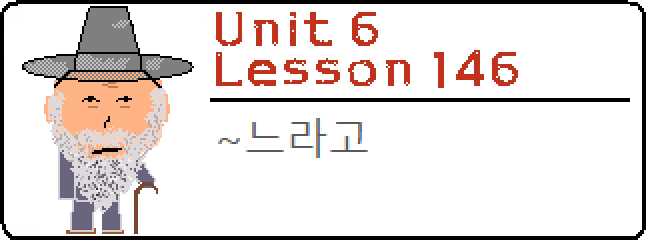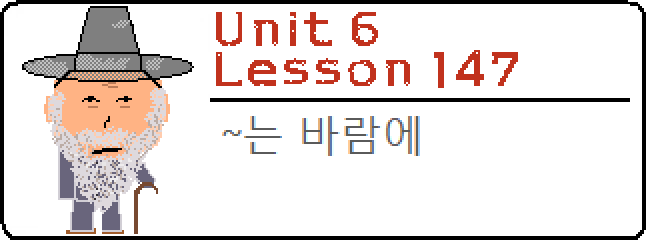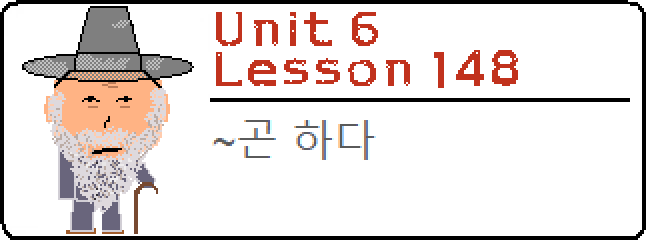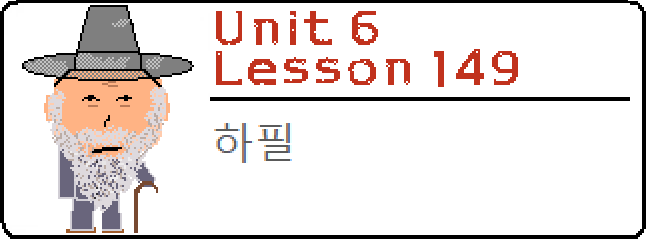 Lesson 142: In this lesson, you will learn a simple and common way to end your sentences with a bit of attitude. You will learn the subtle meaning of ending your sentences with ~ㄴ/는다니, ~다니, ~(이)라니, ~자니, ~(느)냐니 and ~(으)라니. Lesson 142: In this lesson, you will learn a simple and common way to end your sentences with a bit of attitude. You will learn the subtle meaning of ending your sentences with ~ㄴ/는다니, ~다니, ~(이)라니, ~자니, ~(느)냐니 and ~(으)라니. |
 Lesson 143: In this lesson, you will learn how to make or refute a statement in doubt by using ~ㄹ/을걸(요). Although typically used in response to what other people say, it can also be used when one is just talking making a guess. You will learn ways that this is commonly used to make your speech sound more natural. Lesson 143: In this lesson, you will learn how to make or refute a statement in doubt by using ~ㄹ/을걸(요). Although typically used in response to what other people say, it can also be used when one is just talking making a guess. You will learn ways that this is commonly used to make your speech sound more natural. |
 Lesson 144: In this lesson, you will learn how to end your sentences with ~지 뭐 to show that one doesn’t really care what the outcome of a situation is. I don’t really like “one doesn’t really care about what the outcome of a situation is” as a way to translate ~지 뭐. It just doesn’t sound very academic. Instead, let’s translate it to “to resign to the fact that.” Yes, much more academic. Let me break ~지 뭐 down for you and show you how we can use it Lesson 144: In this lesson, you will learn how to end your sentences with ~지 뭐 to show that one doesn’t really care what the outcome of a situation is. I don’t really like “one doesn’t really care about what the outcome of a situation is” as a way to translate ~지 뭐. It just doesn’t sound very academic. Instead, let’s translate it to “to resign to the fact that.” Yes, much more academic. Let me break ~지 뭐 down for you and show you how we can use it |
 Lesson 145: You’ve been learning Korean for a while now. It’s been a few years. You pick up a Korean novel and try to read a few paragraphs to see if you can get in some reading practice. All of a sudden, you see a word ending in ~란. Wait, what is this? This looks similar. You feel like you should know what this means. It must be an abbreviation of some kind, but what is being abbreviated? Lesson 145: You’ve been learning Korean for a while now. It’s been a few years. You pick up a Korean novel and try to read a few paragraphs to see if you can get in some reading practice. All of a sudden, you see a word ending in ~란. Wait, what is this? This looks similar. You feel like you should know what this means. It must be an abbreviation of some kind, but what is being abbreviated? |
 Lesson 146: There are so many ways to create a sentence in Korean where one clause causes the next. Let’s learn about another one! In this lesson, you will learn how to use ~느라고 to connect two clauses to indicate that the reason why the second clause happened is because of the first clause. Of course, it’s not that simple! Lesson 146: There are so many ways to create a sentence in Korean where one clause causes the next. Let’s learn about another one! In this lesson, you will learn how to use ~느라고 to connect two clauses to indicate that the reason why the second clause happened is because of the first clause. Of course, it’s not that simple! |
 Lesson 147: In this lesson, we will learn about ~는 바람에 and touch briefly on the other uses of 바람. This lesson will be similar to the previous lesson because ~는 바람에 and ~느라고 have some similarities, and they both allow a speaker to indicate causality. Lesson 147: In this lesson, we will learn about ~는 바람에 and touch briefly on the other uses of 바람. This lesson will be similar to the previous lesson because ~는 바람에 and ~느라고 have some similarities, and they both allow a speaker to indicate causality. |
 Lesson 148: In this lesson, you will learn how to use ~고는 하다 (or ~곤 하다). It is a fairly simple grammatical principle to use, and unlike some of the other endings we have learned lately, doesn’t have a lot of subtle nuances to it. Lesson 148: In this lesson, you will learn how to use ~고는 하다 (or ~곤 하다). It is a fairly simple grammatical principle to use, and unlike some of the other endings we have learned lately, doesn’t have a lot of subtle nuances to it. |
 Lesson 149: In this lesson, you will learn about the word 하필 and how you can use it in Korean sentences. What does this word mean? What does it translate to? Does it even have a translation? What type of situation should it be used in? We will get to all of this. Lesson 149: In this lesson, you will learn about the word 하필 and how you can use it in Korean sentences. What does this word mean? What does it translate to? Does it even have a translation? What type of situation should it be used in? We will get to all of this. |
 Lesson 150: In this lesson, you will learn another adverb that is hard to translate to English – 어쩐지. It is commonly used in two types of situations, but are those situations actually different? Or are our English minds deceiving us? Lesson 150: In this lesson, you will learn another adverb that is hard to translate to English – 어쩐지. It is commonly used in two types of situations, but are those situations actually different? Or are our English minds deceiving us? |
 Lessons 142 – 150 Mini Test: Test yourself on what you learned from Lessons 142 to 150! A Mini-Test like this will be uploaded after every eight lessons. Don’t worry if the test doesn’t go so well – this website is here to help you! Lessons 142 – 150 Mini Test: Test yourself on what you learned from Lessons 142 to 150! A Mini-Test like this will be uploaded after every eight lessons. Don’t worry if the test doesn’t go so well – this website is here to help you! |
 Lesson 142: In this lesson, you will learn a simple and common way to end your sentences with a bit of attitude. You will learn the subtle meaning of ending your sentences with ~ㄴ/는다니, ~다니, ~(이)라니, ~자니, ~(느)냐니 and ~(으)라니.
Lesson 142: In this lesson, you will learn a simple and common way to end your sentences with a bit of attitude. You will learn the subtle meaning of ending your sentences with ~ㄴ/는다니, ~다니, ~(이)라니, ~자니, ~(느)냐니 and ~(으)라니. Lesson 143: In this lesson, you will learn how to make or refute a statement in doubt by using ~ㄹ/을걸(요). Although typically used in response to what other people say, it can also be used when one is just talking making a guess. You will learn ways that this is commonly used to make your speech sound more natural.
Lesson 143: In this lesson, you will learn how to make or refute a statement in doubt by using ~ㄹ/을걸(요). Although typically used in response to what other people say, it can also be used when one is just talking making a guess. You will learn ways that this is commonly used to make your speech sound more natural. Lesson 144: In this lesson, you will learn how to end your sentences with ~지 뭐 to show that one doesn’t really care what the outcome of a situation is. I don’t really like “one doesn’t really care about what the outcome of a situation is” as a way to translate ~지 뭐. It just doesn’t sound very academic. Instead, let’s translate it to “to resign to the fact that.” Yes, much more academic. Let me break ~지 뭐 down for you and show you how we can use it
Lesson 144: In this lesson, you will learn how to end your sentences with ~지 뭐 to show that one doesn’t really care what the outcome of a situation is. I don’t really like “one doesn’t really care about what the outcome of a situation is” as a way to translate ~지 뭐. It just doesn’t sound very academic. Instead, let’s translate it to “to resign to the fact that.” Yes, much more academic. Let me break ~지 뭐 down for you and show you how we can use it Lesson 145: You’ve been learning Korean for a while now. It’s been a few years. You pick up a Korean novel and try to read a few paragraphs to see if you can get in some reading practice. All of a sudden, you see a word ending in ~란. Wait, what is this? This looks similar. You feel like you should know what this means. It must be an abbreviation of some kind, but what is being abbreviated?
Lesson 145: You’ve been learning Korean for a while now. It’s been a few years. You pick up a Korean novel and try to read a few paragraphs to see if you can get in some reading practice. All of a sudden, you see a word ending in ~란. Wait, what is this? This looks similar. You feel like you should know what this means. It must be an abbreviation of some kind, but what is being abbreviated? Lesson 146: There are so many ways to create a sentence in Korean where one clause causes the next. Let’s learn about another one! In this lesson, you will learn how to use ~느라고 to connect two clauses to indicate that the reason why the second clause happened is because of the first clause. Of course, it’s not that simple!
Lesson 146: There are so many ways to create a sentence in Korean where one clause causes the next. Let’s learn about another one! In this lesson, you will learn how to use ~느라고 to connect two clauses to indicate that the reason why the second clause happened is because of the first clause. Of course, it’s not that simple! Lesson 147: In this lesson, we will learn about ~는 바람에 and touch briefly on the other uses of 바람. This lesson will be similar to the previous lesson because ~는 바람에 and ~느라고 have some similarities, and they both allow a speaker to indicate causality.
Lesson 147: In this lesson, we will learn about ~는 바람에 and touch briefly on the other uses of 바람. This lesson will be similar to the previous lesson because ~는 바람에 and ~느라고 have some similarities, and they both allow a speaker to indicate causality. Lesson 148: In this lesson, you will learn how to use ~고는 하다 (or ~곤 하다). It is a fairly simple grammatical principle to use, and unlike some of the other endings we have learned lately, doesn’t have a lot of subtle nuances to it.
Lesson 148: In this lesson, you will learn how to use ~고는 하다 (or ~곤 하다). It is a fairly simple grammatical principle to use, and unlike some of the other endings we have learned lately, doesn’t have a lot of subtle nuances to it. Lesson 149: In this lesson, you will learn about the word 하필 and how you can use it in Korean sentences. What does this word mean? What does it translate to? Does it even have a translation? What type of situation should it be used in? We will get to all of this.
Lesson 149: In this lesson, you will learn about the word 하필 and how you can use it in Korean sentences. What does this word mean? What does it translate to? Does it even have a translation? What type of situation should it be used in? We will get to all of this. Lesson 150: In this lesson, you will learn another adverb that is hard to translate to English – 어쩐지. It is commonly used in two types of situations, but are those situations actually different? Or are our English minds deceiving us?
Lesson 150: In this lesson, you will learn another adverb that is hard to translate to English – 어쩐지. It is commonly used in two types of situations, but are those situations actually different? Or are our English minds deceiving us? Lessons 142 – 150 Mini Test: Test yourself on what you learned from Lessons 142 to 150! A Mini-Test like this will be uploaded after every eight lessons. Don’t worry if the test doesn’t go so well – this website is here to help you!
Lessons 142 – 150 Mini Test: Test yourself on what you learned from Lessons 142 to 150! A Mini-Test like this will be uploaded after every eight lessons. Don’t worry if the test doesn’t go so well – this website is here to help you!
